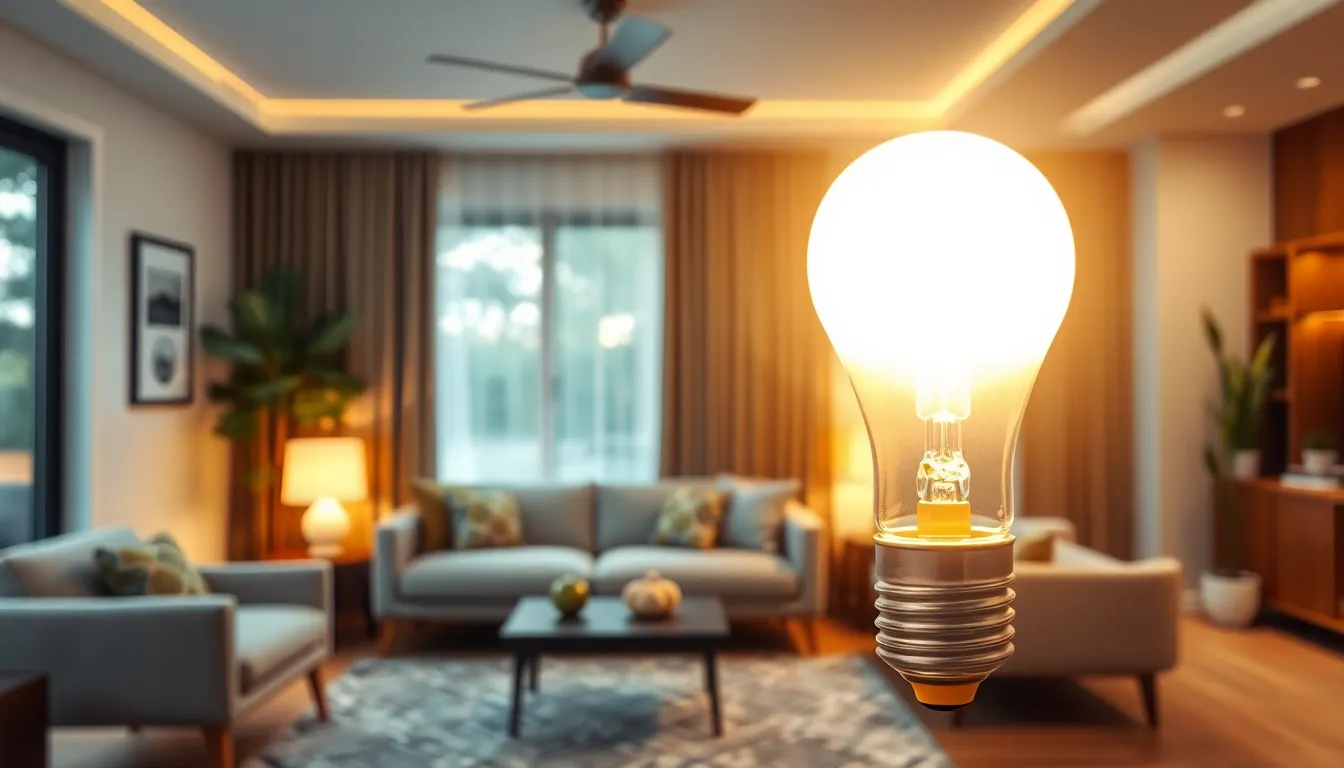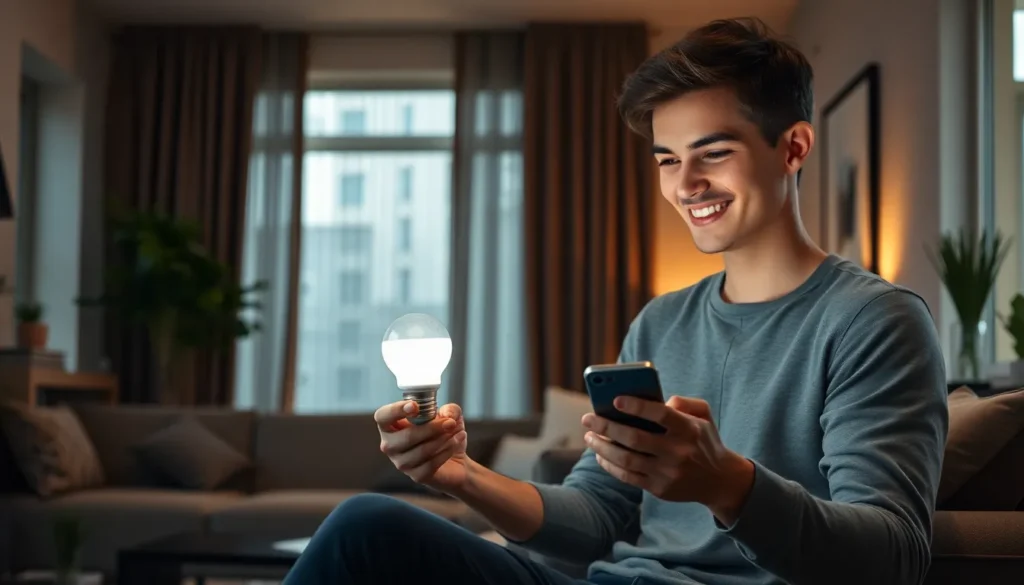Table of Contents
ToggleIn today’s fast-paced world, smart lighting is more than just a trend; it’s a game changer for homes and businesses alike. With the ability to control lighting with a simple voice command or a tap on a smartphone, it brings convenience and efficiency to everyday life. Smart lighting not only enhances ambiance but also contributes to energy savings and security.
As technology evolves, so do the possibilities for illuminating spaces. From choosing the right smart bulbs to exploring automation features, there’s a wealth of options available. Understanding how to effectively implement smart lighting can transform any environment into a more functional and inviting space. Get ready to discover practical tips that will elevate your lighting game and make your life easier.
Overview Of Smart Lighting
Smart lighting incorporates advanced technology that enhances both functionality and convenience in lighting systems. Smart bulbs often connect to wireless networks, allowing control through smartphones, tablets, or voice-activated devices. This connectivity supports various lighting modes, including brightness adjustments and color changes, catering to specific moods or activities.
Energy efficiency represents a significant advantage of smart lighting. Traditional bulbs consume more energy compared to LED smart bulbs, which use up to 80% less energy while providing the same level of brightness. This reduction contributes to lower electricity bills and a smaller environmental footprint.
Automation features enhance the practicality of smart lighting. Users can program schedules for when lights turn on or off, which helps in conserving energy when spaces are unoccupied. Many systems integrate with home security setups, enabling lights to mimic occupant behavior, thereby deterring potential intruders.
In addition, smart lighting can improve ambiance through customizable options. Users can set different light colors and intensities for various occasions, such as warm tones for relaxation or bright white for tasks. These features not only elevate the aesthetic appeal of any space but also promote well-being by aligning lighting with human circadian rhythms.
Overall, smart lighting transforms spaces, providing practical benefits while enriching the user experience through innovative technology and intuitive control.
Benefits Of Smart Lighting

Smart lighting offers various advantages that enhance both functionality and user experience. It promotes energy efficiency and provides exceptional convenience and control.
Energy Efficiency
Energy-efficient smart lighting significantly reduces electricity consumption. LED smart bulbs consume up to 80% less energy than traditional incandescent bulbs. Automation features, such as motion sensors and programmable schedules, further conserve energy by turning off lights in unoccupied spaces. According to the U.S. Department of Energy, energy-efficient lighting can lower annual electricity costs by an average of $30 per bulb. The reduction in energy use not only lowers bills but also contributes to a healthier environment.
Convenience and Control
Smart lighting systems offer unparalleled convenience and control. Users can manage lighting via smartphones, tablets, or voice-activated devices, enabling immediate adjustments without physical interaction. Customizable settings allow users to create specific lighting scenes for different activities, such as reading or entertaining. Integration with smart home systems enhances convenience by allowing users to automate lighting in conjunction with other devices, such as thermostats and security cameras. This level of control fosters an intuitive living environment that adapts to individual preferences and routines.
Choosing The Right Smart Lighting System
Selecting the appropriate smart lighting system can significantly enhance the functionality and efficiency of any space. Understanding the different types of smart bulbs and controllers available helps make an informed decision.
Types of Smart Bulbs
Several categories of smart bulbs cater to various needs and preferences:
- LED Smart Bulbs: These bulbs use up to 80% less energy than traditional incandescent bulbs and provide customizable brightness and color.
- Smart Candelabra Bulbs: Ideal for decorative fixtures, these bulbs combine efficiency with style, offering unique designs for ambient lighting.
- Smart A19 Bulbs: Commonly used in table lamps and fixtures, these standard-shaped bulbs suit various applications and provide flexibility in multiple settings.
- Smart Light Strips: They offer creative lighting options, perfect for accentuating architectural features or enhancing entertainment spaces with vibrant colors.
Smart Lighting Hubs and Controllers
Smart lighting hubs and controllers simplify managing multiple devices across a network:
- Smart Hubs: Devices like Samsung SmartThings and Philips Hue Bridge centralize the control of different smart bulbs, streamlining setup and operation.
- Voice Assistants: Integrating with platforms like Amazon Alexa or Google Assistant allows for voice-activated control, improving accessibility.
- Mobile Apps: Most smart lighting systems offer dedicated apps, enabling users to customize settings, create schedules, and monitor energy usage from smartphones.
- Routines and Automation: Hubs can automate lighting sequences based on time, events, or occupancy, enhancing energy conservation and security.
Selecting the right smart lighting components ensures an optimized and energy-efficient lighting experience tailored to individual preferences.
Installation Tips For Smart Lighting
Effective installation ensures optimal performance of smart lighting systems. Following specific guidelines can enhance functionality and user experience.
Wireless Setup
Select a reliable Wi-Fi network to enhance connectivity between smart lighting devices. Ensure the router’s placement allows for maximum coverage in all intended areas. Utilize a smart bulb compatible with the chosen hub or app, allowing for seamless integration and control. Prioritize bulbs with robust signal strength to avoid connectivity issues, especially in larger spaces. Test the smart lighting system after installation to confirm optimal performance and responsiveness to commands.
Wiring Considerations
Evaluate existing wiring to ensure compatibility with smart lighting solutions. Use LED smart bulbs designed to fit standard sockets, which simplifies installation and promotes efficiency. Consider employing a qualified electrician for complex installations, particularly for hardwired systems or when retrofitting existing fixtures. Secure connections are essential; verify that all wiring adheres to local electrical codes for safety and compliance. Implement smart switches if desired, which can add enhanced control options while integrating with the broader smart home system.
Smart Lighting Techniques
Smart lighting techniques enhance energy efficiency, convenience, and ambiance, boosting the overall experience in homes and businesses. Employing effective strategies maximizes the benefits of smart lighting technology.
Scene Setting
Scene setting features customizable lighting adjustments tailored for specific activities or moods. Users can create various scenes, such as:
- Movie Mode: Dim lights for a cinematic experience, enhancing viewing comfort.
- Reading Nook: Brighten areas designated for reading, reducing eye strain.
- Mood Lighting: Use warm hues to create a calming atmosphere during relaxation or entertaining.
By pre-setting preferred conditions, users can effortlessly switch between scenes, enhancing the functionality of smart lighting systems.
Automation and Scheduling
Automation and scheduling optimize energy use and provide convenience. Users can implement these strategies:
- Daily Routines: Program lights to turn on and off at designated times, promoting a sense of security.
- Vacation Modes: Mimic occupancy by scheduling lights to activate at various times, deterring potential intruders.
- Smart Integrations: Sync lighting with smart home systems to automatically adjust based on external factors, such as daylight conditions.
Utilizing automation features not only conserves energy but also creates a responsive living environment that aligns with personal schedules.
Smart lighting represents a significant leap in how individuals interact with their environments. By embracing this technology, homeowners and businesses can create spaces that are not only energy-efficient but also tailored to their unique needs. The ability to customize lighting scenes and automate schedules enhances convenience and promotes well-being.
As users explore various smart lighting options and installation techniques, they’ll find that integrating these systems into their daily lives can lead to a more enjoyable and efficient atmosphere. Investing in smart lighting is more than just a trend; it’s a step toward a smarter and more sustainable future.





